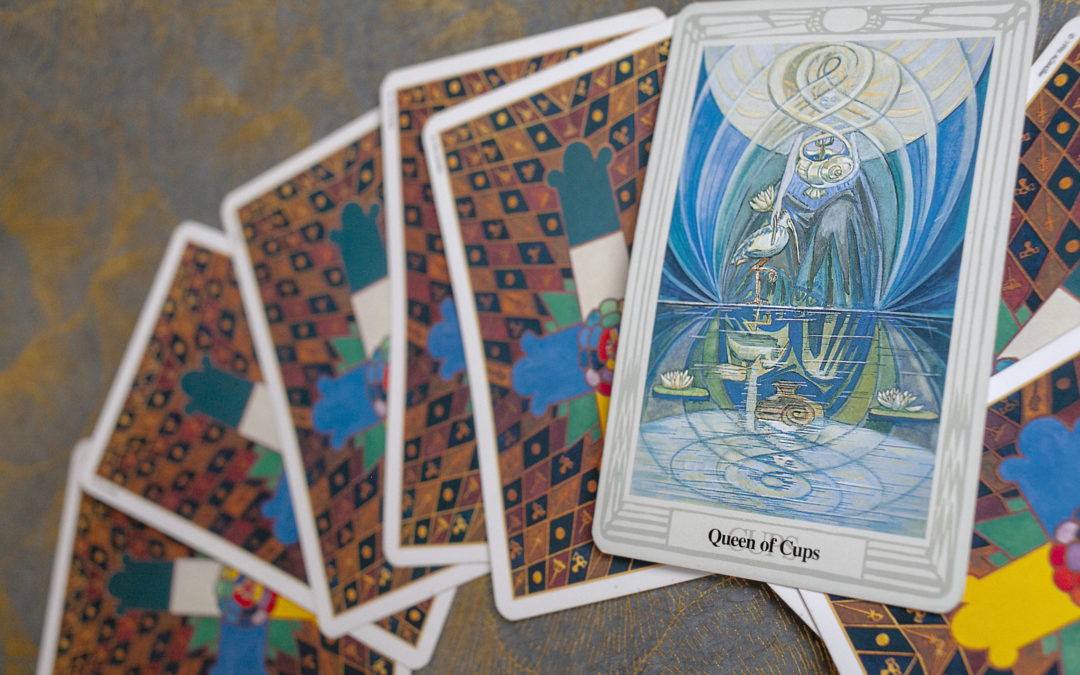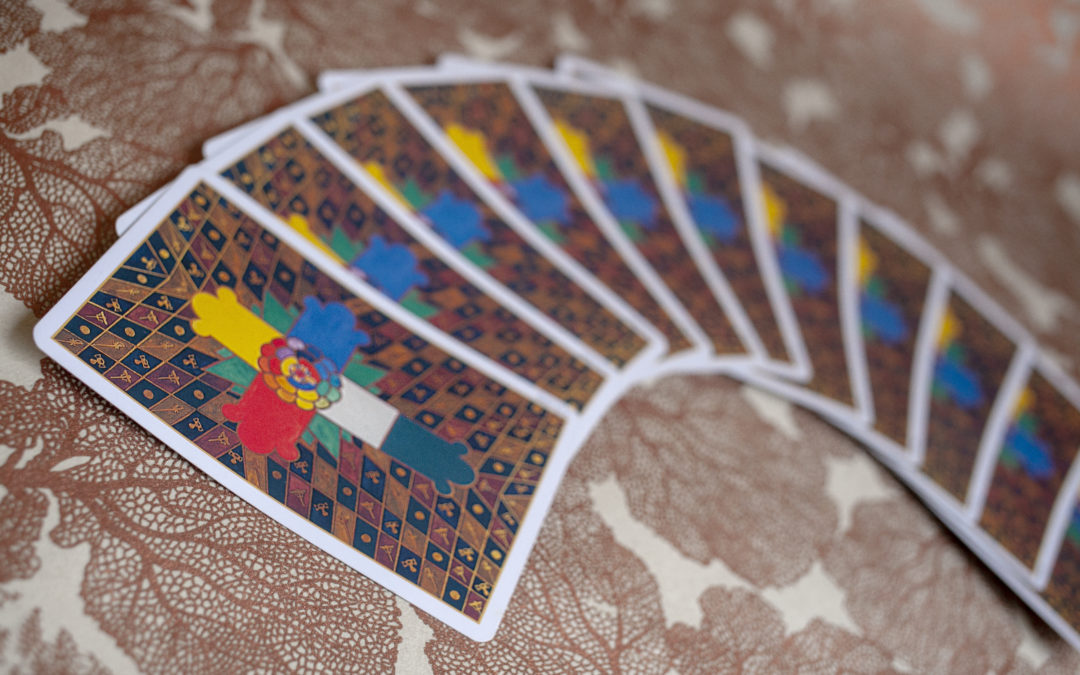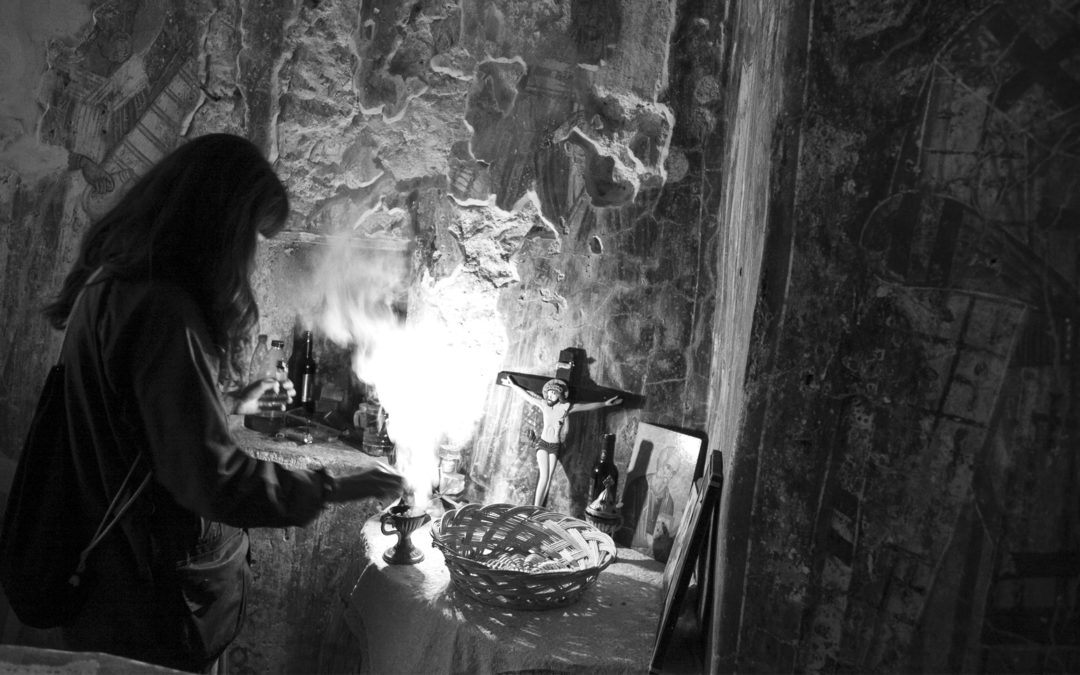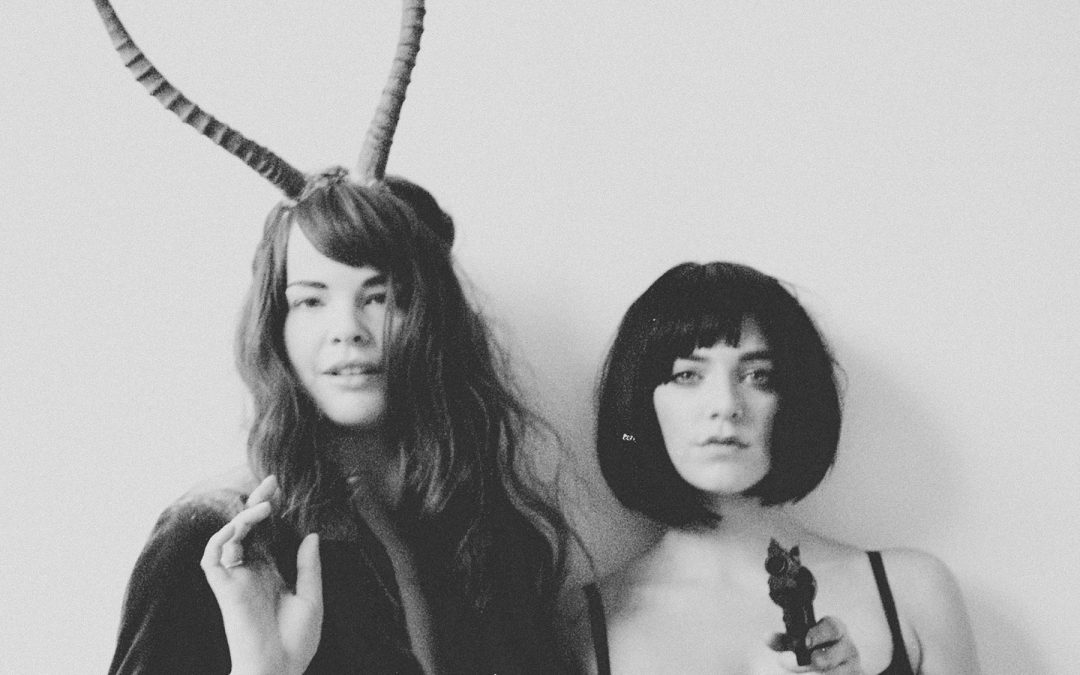
Queen of Cups
When I first glance at the Queen of Cups, my eyes land on the shell in her palm. Her face is hard to locate: I work back from the reflection, where her eyes gaze plaintively from the water. In her shell, a crayfish stands on end, forming the shape of Neptune’s trident. The Queen holds a lotus with her free hand, which she also drapes over the head of a stork. Two more lotuses glimmer from the pond: possibly representing the twin nature of Gemini.
The Queen of Cups rules the 21st degree of Gemini to the 20th degree of Cancer, according to Crowley’s Book of Thoth. If this looks like the least Gemini card in the deck, Crowley has a riposte: Instead of assigning the three decans of each sign to one card, the influence begins with the last decan of one Sign and continues to the second decan of the next…The reason for this is that in the realm of the Elements all things are mixed and confused; or, as the apologist might say, counter checked and counter-balanced.
For Crowley, the lotus represented Isis, a divine mother in Egyptian mythology, who helped resuscitate her dead husband, Osiris. Imagine a lotus blossom on the surface of the Nile. The flower represents both the physical world and the entrance to the spirit realm below. To quote the Beautiful Isis blog: the water’s reflection of the petals “suggests the ghostly reflections of either realm when viewed from an alternative or parallel reality.”
I think of people with prominent water or Neptune placements. How they have such ready access to other people and other realms. They are the empaths, the seers, the dreamers. But it’s not always easy to identify what belongs to you and what you’re absorbing from others.
I think of the symbols: how the glyph for Cancer appears like a reflection off water (so too for Gemini, of course.) How the moon doesn’t produce light of her own, but offers the perfect curve in the sky to scoop the sun back to us.
Angeles Arrien describes the Queen of Cups as mastery of emotional integrity. This Queen represents Mother, how we nurture, and the practice of “owning one’s feelings and expressing them without blame or judgment.”
Now that’s not something we’re encouraged to do everyday. Arrien stresses this point. The Queen of Cups does not repress her feelings, nor use them to attack. But she doesn’t apologize for her feelings either.
A Cancer Queen at her finest.

The Book of Thoth
Aleister Crowley named his tarot deck the Book of Thoth after many ancient texts of the same title, attributed to the Egyptian god of writing and knowledge.
The deck itself was illustrated over five years by Lady Frieda Harris, who became a close friend to Crowley. I know a few people who don’t touch this deck, because of Crowley’s dark reputation. I’m not going to argue he was a nice, or even “good,” guy, but my feeling is that no deck is dark or evil on its own. It’s a medium. Like any medium, it channels the energy you pour through it (or the energy that pours from the other side.) The deck is blunt, certainly, owing to the words that caption the grimmer minor arcana, such as the 7 of disks (“failure”) or 10 of swords (“ruin.”) But the artwork is breathtaking, and like any deck, it has a sense of humour.
When I got back into tarot as an adult, the Thoth deck appealed to me because of its astrological correlations. (If you look closely, astrological symbols are painted on many of the minor arcana cards… the 7 of Cups (“Debauch”) is represented by Venus in Scorpio, for instance.)
I already possessed basic knowledge of astrological language, so I thought this deck might be more intuitive to work through. Though we didn’t know each other at the time, Jasmine was drawn to the same one.
As we travelled together for three weeks in Greece and Egypt, we continued to consult our cards. What we found is they sent us the same messages. Loudly at times. One evening, we had the idea to draw cards from each other’s decks to receive guidance on whether to proceed, or not, with an idea. We drew exactly the same card: the 8 of swords. (“Interference.”) Jasmine went on to flip this card at least four more times over the next forty-eight hours. And this is what we found: if there was a message we needed to receive, it came through. If we didn’t listen the first time, the deck would repeat herself.
Over the last few months, as we’ve come together under the banner of Kosmic Tonic, we’ve repeatedly drawn the same card. (“Art” has made a regular appearance: Thoth’s Temperance. As has Aeon: Judgment.) I’ve been getting to know this deck over my Fall in Switzerland, but I still find some of the astrological correlations a mystery. For instance: the 9 of disks, “Gain,” is represented by Venus in Virgo, where’s she’s technically in her fall. And Thoth links the 5 of cups, “disappointment,” to Mars in Scorpio, where he’s domicile. Crowley designed this deck according to his own understanding of the decans, which originated in Egyptian astrology, I’ve recently learned. (Shout out to Chris Brennan’s book on Hellenistic Astrology!) Crowley was more influenced by the Kabbalah and other occult histories than a direct interpretation of the essential dignities, I suppose. But it still niggles at me. I want to knit the gap between some of his astro correlations and the cards as I’ve studied them.
This is all a rather long-winded precis to announce that we’re going to use our blog as an online Thoth laboratory of sorts. We don’t claim to be experts, but we hope to lean into the cards, brainstorm their astrological links, and start a wider conversation with anyone else willing or curious.

We Came for the Goddesses and Spent All Our Time in Churches and Mosques
The inspiration behind our trip to Greece and Egypt was to visit sites where the ancients had honoured the gods. Specifically, the gods we tracked in astrology, attached to planets and asteroids. And we did experience something like reverence as we wandered the hill of the acropolis, or the ancient agora, where I mouthed a prayer to Mars at the temple of Ares. Only sixteen columns of the Temple of Olympian Zeus remain standing, but they’re so magnificent, they exude an aura of might and divinity. (Jupiter rules my sun, so I spent some time here, blessing Hestia and Hermes statues for my altar.) I felt that same awe for the Great Sphinx of Giza (I’m a Leo rising, and I’ve always been a cat person), but I can’t say any of these spaces felt sacred beyond my own projection of myth and magic.
And why should they? Tourism accounts for 20% of Greece’s GDP and 11% of Egypt’s (a number that’s dropped since the Revolution). Who are we to seek something deeper from these spaces, which have not been magic or consecrated for thousands of years. Or rather: we can seek all we like, and certainly it is transporting to walk the same stone and sand of ancient worshippers. But your moment of quiet reverence be interrupted by streams of tour buses and vendors trying to sell you camel rides. To expect anything less would be naive, west-centric and ahistorical.
Jasmine and I didn’t consider this consciously at the time. We just found ourselves gravitating toward churches and mosques. In the mountains southwest of Chania, we found a vacant roadside chapel, painted with fourteenth century icons, smelling of black mould and catshit. A candle the height of my body leaned against the wall. Before long, I was lighting the wick to better view the icons and Greek prayer book on the altar. At first, I was just fucking around. Then a feeling of respect (even shame?) settled on me. I left a few Euro in the donation jar and burned a lump of Frankincense at the front.
In an orthodox church, one psalm that commonly accompanies the censing goes like this: “Let my prayer arise in Thy sight as incense, and let the lifting up of my hands be an evening sacrifice.” Is this so different from burning incense to invoke air, or the guardians of the East?
In Cairo, Jasmine and I both felt moved, even silenced, by the calls to prayer every morning. Visiting mosques inspired that same respect and quietness in us. Throughout our trip, we found ourselves visiting sites of present-day worship over the ancient temples we had come for. As if the charge of all those people still praying felt more aligned with what we were seeking, whatever your word for it: divinity, the mysteries, or simply a glimpse at the other side.

Neptune
We’ve been friends since November, astrology partners since March, yet we never bothered to glance at our composite. That is, until we had to elect a date for our website launch. If you’re thinking, “what about compost?”, let me explain. The composite chart is a synastry technique that hints how two people interact with each other. It’s drawn by calculating the midpoints between two natal charts. I’m an individual. Jasmine’s an individual. And we project this third entity between us, our relationship, with its own chart. The first signature you may note is Holy Scorpio, Batman. The composite sun functions as the battery pack of the relationship. In Scorpio, you might say we’re not afraid of the dark, and we like swimming. Deep. We also have Neptune conjunct the south node on the galactic centre. We’ll explore nodes another time—as well as the galactic centre—but for now you can think of the south node as the well we draw from: our natural resources and what feels easy to us. The south node also suggests release: the tail of the dragon, which Vedic astrologers know as Ketu. Neptune is Ocean. The sea fabric of dreams. Inspiration. Spirit. Libation. Confusion. Consciousness. As the last sign of the zodiac, Pisces holds the blurry waters between the end and the start. The grief, love and lessons of all that preceded it, before loosening once more into spring. We began our instagram account on the Pisces new moon of March 17, 2018. And we’re launching our website in the waning light of the full moon last week. In our separate charts, Jasmine and I have opposite nodes along the Pisces-Virgo axis. So we spend time bathing in his waters as individuals as well. What does this mean for our work together? Inspiration, we hope. Dreaming. Empathy. Magic. Two fish swimming together from opposite ends of the pool. Come for a dip?
